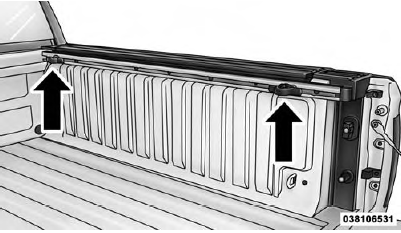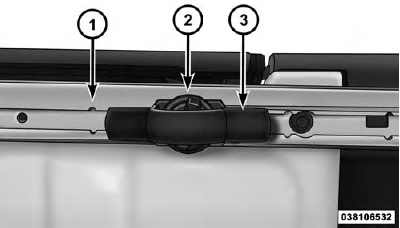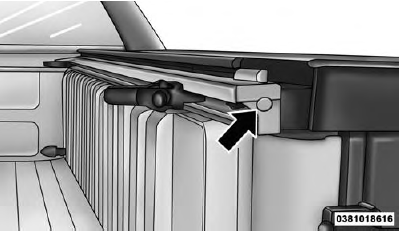Ram 1500/2500/3500: Bed Rail Tie-Down System
CAUTION!
The maximum load per cleat should not exceed
250 lbs (113 kg) and the angle of the load on each cleat
should not exceed 45 degrees above horizontal, or
damage to the cleat or cleat rail may occur.
There are two adjustable cleats on each side of the bed
that can be used to assist in securing cargo.

Adjustable Cleats
Each cleat must be located and tightened down in one of
the detents, along either rail, in order to keep cargo
properly secure.
To move the cleat to any position on the rail, turn the nut
counterclockwise, approximately three turns. Then pull
out on the cleat and slide it to the detent nearest the
desired location. Make sure the cleat is seated in the
detent and tighten the nut.

- Utility Rail Detent
- Cleat Retainer Nut
- Utility Rail Cleat
To remove the cleats from the utility rail, remove the end
cap screw located in the center of the end cap, using a
#T30 Torx head driver. Remove the end cap and slide
the cleat off the end of the rail.

Utility Rail End Cap
READ NEXT:
Camper Applications
Certain truck models are not recommended for slide-in
campers. To determine if your vehicle is excluded, please
refer to the "Consumer Information Truck-Camper Loading"
document av
To simplify mounting of a camper unit with an overhang,
the tailgate can be removed.
NOTE: If your vehicle is equipped with a rear camera or
RKE the electrical connector must be disconnected prior
to
Your vehicle may be equipped with a Tri-Fold Tonneau
Cover which consists of different features:
Easy Tri-Fold cover
Tonneau fore aft locator
Crosscar inside bed locator
Front and rear clamps
St
SEE MORE:
The wipers and washers are operated by a switch in the
multifunction lever. Turn the end of the handle to select
the desired wiper speed.
Windshield Wiper/Washer Switch
Windshield Wiper Operation
Rotate the end of the lever upward, to the first detent past
the intermittent settings for low-speed wi
Head restraints are designed to reduce the risk of injury
by restricting head movement in the event of a rear
impact. Head restraints should be adjusted so that the top of the head restraint
is located above the top of your ear.
WARNING!
The head restraints for all occupants must be properly
adjust




